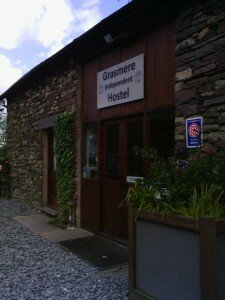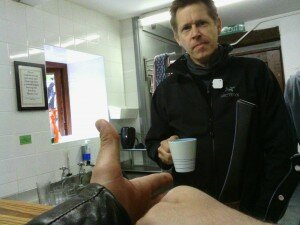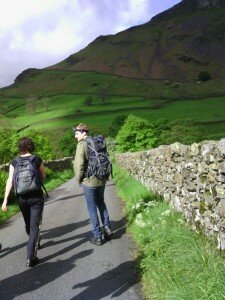
Last month we organized an internal 3-day event for gathering experience on how comprehensive imagery life-logging works, both from a technical point of view as well as from a participant’s point of view. From May 20-23 the Lancaster team rented a small hostel up in the Lake District, UK, for us, and lugged up plenty of food and technical equipment to keep us busy (and well fed) during the three days. The advantage of this rural setting was that we could rent the entire hostel for the team, hence minimizing the chances that other guests would be caught on one of our many cameras. Our only outside contact was a lady that brought us light luncheons each day, as well as the hostel owner who checked us in the first day. Each site brought different capturing devices, thus transforming the hostel into “RECALL House” — an instrumented environment (a very much simplified version of the MIT PlaceLab if you will) geared towards capturing imaging data from all participants during most of our waking hours.
The Lancaster team brought half a dozen of movement triggered surveillance cameras that could capture both video and audio. Stuttgart brought 3-4 stationary time-lapse cameras and 4 GoPro cameras with both chest and head mount options, and each team brought their clip-on cameras for a total of more than 20 Narrative clips and 2 Autographers.

We really liked the Narrative clip — a tiny wearable camera that automatically takes pictures every 30 seconds. One can also double tap it to manually take a picture of a particular moment. While it features both a 3D accelerometer and a GPS receiver, the actual position is not computed on the clip in order to save battery – one needs to upload the raw measurements to the manufacturer’s server if one needs this information. The Autographer is bigger in size and offers the same functionality (with a few extra sensors thrown in, such as temperature), though here positioning information is actually computed locally on the clip. They are both similar to the very well known Microsoft SenseCam, but much more compact in size and thus much easier to wear every day.

The GoPro camera is wearable and mountable onto many different objects, including cars, helmets, kites or skateboards. While it offers incredible picture quality, our four GoPros lasted hardly more than 90 minutes, making them inconvenient for prolonged recordings. Of course, their weight and awkward mounting options means they are rather unsuited for everyday use.
To test our cameras “in the wild”, we started our stay with a nice hiking activity, all wearing Narrative clips or Autographers, while two team members had both chest and head mounted GoPros. In a subsequent session, the team worked through dinner preparations with their cameras on. In this setting, the (recharged) GoPros really showed off their incredible picture quality, offering a very rich recording of the various cooking activities from various angles. Last but not least, our fully instrumented meeting room saw lots of planning, brainstorm, and analysis activity — all captured by two dozens wearable and room-mounted cameras.

This experiment was a great opportunity for all members to develop a deeper understanding on visual data acquisition in general, and everyday life-logging in particular. Over 200’000 images and almost 100 hours of video segments provided the Recall team with an authentic data set on which to develop our initial set of prototypes in the upcoming months.